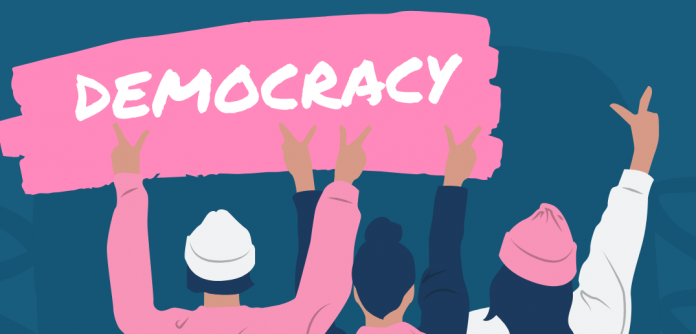This article is written by Adhila Muhammed Arif, a student of Government Law College, Thiruvananthapuram. This article seeks to explain the concept of direct democracy, its different forms or instruments, pros and cons of direct democracy, and its application in the modern-day world.
This article has been published by Sneha Mahawar.
Table of Contents
Introduction
Most countries in modern times practice democracy by electing people who can act as their representatives, who can make important decisions and draft policies, and take appropriate legal and political actions. But when democracy was first introduced in Rome and Greece, it was practiced differently. Every citizen had the chance to directly engage in the decision-making process instead of indirect participation through elected representatives. While the practice of direct participation of citizens, or direct democracy, is outdated, there are certain elements of it that still have a place in today’s world.
Let us first look at the definition of direct democracy.
Definition of direct democracy
Direct democracy essentially refers to a political setup allowing the public to directly vote on important political matters such as those concerning the Constitution, legislation, and treaties, instead of participating in such processes through their elected representatives. This is the antithesis of the system of representative or indirect democracy. A popular example of direct democracy in today’s world is Switzerland. Unsurprisingly, it is rare to find direct democracy as a form of government in this modern age due to the impracticability of engaging the entire population in legal and political processes.
Forms of direct democracy
The most common forms of direct democracy are referendums and citizen’s initiatives.
Referendums
- A referendum is a mechanism by which a citizen can vote on a legal issue, which may bind or may advise the governmental body that refers to the issue to be voted upon.
- The votes will have the effect of accepting or rejecting the government’s proposals or decisions or even ratifying or repealing a provision.
- A popular example of a referendum is the Brexit of the United Kingdom, which is regarding whether the UK must exit the European Union. This took place on January 31st, 2020. This was one of the most talked about referendums in the history of international politics. The referendum resulted in the UK leaving the EU after almost 52% of the votes were in favour of Brexit.
- The Catalan independence referendum is another example of a referendum in Catalonia that was a part of the controversial Catalonian independence movement that started in the 19th century. The referendum that was held in 2017 was in favour of independence. But there were debates and controversies regarding the legitimacy of the results, as certain findings pointed towards irregularity in voting. According to the European Commission, which is the EU’s executive body, this referendum was illegal. Thus, to date, this referendum has not been implemented, unlike the Brexit referendum.
Citizen’s initiative
- It essentially refers to a direct vote, whether it is binding or advisory, on a specific legal issue that is initiated by the people.
- It usually leads to the making of a new law or a constitutional amendment.
- A citizen’s initiative is usually in the form of a petition that contains signatures.
- For instance, the European Union has a Citizens’ Initiative Forum that enables and assists EU citizens to hold initiatives. The European Citizens’ Initiative was introduced by the Lisbon Treaty of 2007. One such initiative was the “Minority Safe Pack”, which was for protecting cultural and linguistic minorities. Another successful initiative was “End the Cage Age”, which proposed banning cages for animals such as farmed rabbits, quail, ducks, geese and so on.
However, direct democracy cannot be restricted to these two instruments. There are other notable forms of direct democracy, such as abrogative referendums and recall votes.
Abrogative referendum
- This instrument is used in Italy and it allows people to vote on repealing a law that has been enacted by parliament.
- It is similar to a referendum due to its abrogative characteristic. Yet, it is in the form of a referendum as it is essentially in the form of a public petition.
- Recently, in the month of June 2022, an abrogative referendum was held in Italy, which proposed to repeal certain decrees or articles that regulated the functioning of the judicial system. The referendum, however, did not meet the minimum requirement of turn-out.
Recall vote or recall elections
- In certain constituencies, citizens are allowed to remove an elected representative from his post.
- It is an excellent mechanism to check the efficiency of elected public officials.
We know that direct democracy is the antithesis of representative democracy or indirect democracy. So let’s discuss the major differences between the two.
Difference between direct and indirect democracy
- Direct democracy, or pure democracy, is essentially a system in which citizens can be directly involved in the decision-making process without mediation from elected representatives. In an indirect democracy or representative democracy, people have limited autonomy in the decisions and policies formulated. They can only elect representatives who will in turn make such important decisions.
- Direct democracy can be used as a form of government in countries with less population. But it will not be effective in countries with large populations. Hence, countries with large populations choose representative democracy. For instance, if we implement direct democracy in India, it will most likely fail. Most factions of our population do not get adequate access to information that is needed to decide on an important policy matter. As a fairly large country with a large and diverse population, India spends thousands of crores on every major election. Incorporating elements of direct democracy will only increase expenses even more. Moreover, frequent elections and referendums will cause fatigue among the masses.
- The different forms of direct democracy are mainly referendums, citizen’s initiatives, abrogative referendums, and recall elections. An indirect democracy can be in the form of federalism, a unitary system, a presidential or parliamentary system, or a mixed variation of such forms.
Advantages of direct democracy
Promoting participation in politics
One of the positive aspects of direct democracy is that it encourages citizens to be more aware of the political situation in their nation and also allows them to participate in the decision-making process.
More autonomy for ordinary citizens
Direct democracy benefits citizens as it gives them more autonomy or control over the policy-making process, whereas, in an indirect democracy, the citizens have their autonomy limited to electing their representatives. The autonomy given by direct democracy allows citizens to not have to fully depend on their elected representatives as proxies, which is known as popular sovereignty,
Transparency
Direct democracy allows citizens to have a transparent relationship with their government. It allows them to express their preferences on important political matters freely. The government will also be forced to let citizens have access to crucial information that influences the decision-making process.
Democracy in its purest form
The concept of democracy in itself is centred around giving the power to make decisions to the general public. In indirect democracies, democracy is practiced by appointing ministers and members of the legislature through elections, which allows citizens to be involved in the decision-making process indirectly. Though this is convenient, it does not achieve the “rule of the people” in its truest sense. This is, however, possible by practising indirect democracy. This is why direct democracy is also known as “pure democracy.”
Forces the government to enact important laws
Through elements of direct democracy, citizens can suggest and push the legislature to amend the already existing laws or implement new laws pertaining to issues that concern them. It is likely that the legislature may hesitate to deal with or be unaware of crucial issues that impact the general public. Direct democracy is a doorway for the citizens to push the government to attend to their needs.
Prevents unexpected changes in the law
Through referendums, governments can propose laws or amendments to the citizens, upon which they can cast their votes. With this, they will not find any unexpected changes in the law and they can also have a say in the law-making process.
Now, let’s also look at the demerits of this system.
Disadvantages of direct democracy
The irrationality of the voters
Most voters may vote irrationally, without considering or weighing all the positive and negative aspects of a certain policy. It is very likely that many voters will be led by their emotions instead of making a decision based on facts. This is most likely to happen if the proposed policy touches upon sensitive issues like minority rights, reservation, abortion, arms control, and so on. This is one of the major flaws in practising direct democracy.
Polarisation
Using instruments of direct democracy can also lead to polarising opinions on controversial issues by stripping off their nuances. This is likely to lead to instability in the country’s political climate.
Harms the rights of minorities
Another thing that direct democracy could compromise is the rights of minorities. Instruments of direct democracy are capable of giving effect to the shallow interests of the dominant communities, which can undoubtedly marginalise the oppressed communities even more.
Coherence of policies and lack of accessibility to information
A major hurdle that impacts the effectiveness of direct democracy is the availability of information to the public. The accessibility of adequate and credible information is critical to citizens when casting a vote on an important policy matter. It wouldn’t be surprising if certain interest groups fueled propaganda and spread misinformation amongst the public. Another obstacle is the ability of the public to fully comprehend the proposed solutions or laws. In many situations, it is likely that a layman will find it difficult to fully make sense of the complexities of the proposed policies to vote on them.
Higher expenses
Democracy in itself is an expensive affair as the holding of regular elections takes up a lot of time, resources and funds. The practice of voting on policy matters is likely to add more burdens to the economy of a democratic country. Even the voters might become reluctant to participate if such events keep happening.
Shifting responsibilities from politicians to the common folk
Practising direct democracy defeats the purpose of appointing elected representatives. It is the members of the legislative organ that must take appropriate decisions and draft policies. However, direct democracy shifts this responsibility onto the voters who elect them in the first place.
Lobbying by the elite
Another major disadvantage posed by direct democracy is that it gives opportunities for the elite or the influential upper class of society to meddle with the policies of the country. The ones with the most monetary and social capital will be able to fulfil their selfish interests through the instruments of direct democracy.
Now, after viewing the advantages and disadvantages of direct democracy, let us move on to see how in the 21st-century direct democracy is used as a form of government in Switzerland.
Direct democracy in Switzerland
History of democracy in Switzerland
Prior to the French Revolution, Switzerland was made up of 13 Cantons, which is the equivalent of 13 states. Each Canton exercised sovereignty in internal matters, whereas the Swiss Confederation exercised power over foreign or international matters. The Diet, which is the modern equivalent of a Parliamentary Assembly, consisted of the representatives or agents of each Canton. The Diet met at one of the Cantons on an irregular basis to deliberate on important issues concerning public policy. Such decisions, however, were never legally binding on each Canton unless they were unanimously taken. This gives us an insight into how there was no centralised agency that imposed its power on each Canton. The Swiss Confederation was simply a loose alliance of the Swiss Cantons, where the Swiss Cantons possessed more power and autonomy.
After the French invasion, Switzerland was reorganised to form a centralised government that controlled the Cantons. Due to the massive public outrage, the French government was forced to switch to a federal structure. In 1848, a Federal Constitution was drafted, though the country was still referred to as the Swiss Confederation, and this remained in force till 1874.
In 1999, they adopted a new Constitution, which is still in force to this day. It officially marked the country as a federation. There is a proper distribution of powers between the Federation and the 26 Cantons. Each Canton has its own Constitution.
Instruments of direct democracy in Switzerland
Since the year 1848, Switzerland has been implementing its two instruments of modern direct democracy, which are the referendum and the citizen’s initiative. Swiss voters can initiate any proposal for new legislation or even a constitutional amendment, and it gets implemented if it receives widespread support. Through a referendum, a proposed law is referred to the electorate, which can vote upon it. An ancient instrument of direct democracy in Switzerland is the Landsgemeinde, which is only practised in 6 Cantons at present. This refers to an open town meeting that allows every adult male to speak, make laws on his own and elect officers.
Direct democracy is, however, not limited to Switzerland. There are other countries that use direct democracy as a form of government but to a lesser extent.
Other modern examples of direct democracy
Sweden
- Consultative referendums: A consultative referendum can be initiated on any legal or political matter, but it is merely advisory. It can only be initiated by the parliament at its discretion.
- Constitutional referendums: First, 1/10th of the members have to demand a referendum. If 1/3rd of the parliament’s members approve the referendum, it can be initiated during the general election. The final decision rests with the parliament. If the referendum says yes to the amendments, the parliament has no choice but to go forth with the amendments. However, if the referendum says no to the amendments, they still have the discretion to go forth with the amendments.
Uruguay
- Rejective referendum: This referendum is to reject a law passed by the legislature during the previous year. But it cannot be initiated on financial subjects such as tax imposition. It can be initiated by 25% of the electorate.
- Legislative initiatives: Like the rejective referendums, it can be initiated by 25% of the electorate, which has the effect of proposing a law.
- Constitutional citizens’ initiatives: This is to propose constitutional amendments that require the initiation of at least 10% of the electorate. It is binding if approved by at least 35% of the electorate.
Latvia
- Constitutional referendums: These are referendums that are mandatory if passed by at least half of the voters. They are mandatorily initiated by the parliament after proposing constitutional amendments.
- European Union treaty referendums: Such referendums are to make changes to the relationship between Latvia and the European Union. The parliament has the discretion to initiate it and it is adopted if approved by a majority of the voters.
- Citizens’ initiatives: It can be on any legal matter, excluding budget and finance laws, mobilisation, declaration of war, treaties, and emergencies. It is in the form of a petition to the President, and it must be initiated by at least 1/10th of the electorate. It is binding if approved by the majority.
- Dissolution referendums: It is initiated by the President to dissolve the legislature. The Parliament is dissolved if more than half the votes favour the dissolution, and if not the President gets dismissed.
Ghana
- Referendums on changing regional boundaries: It is mandatory and is adopted if passed by 80% of the voters, with 50% turnout being compulsory.
- Constitutional referendums: These are initiated mandatorily and are passed only if approved by 75% of the voters, with at least 40% turnout.
- Referendums on other matters: These are only initiated at the discretion of the legislature and they may bind if passed by 70% of voters, with at least 35% turnout.
Botswana
- Constitutional referendums: These are referendums that are mandatory if passed by a simple majority of the voters.
Historical examples of direct democracy
Athens, Greece
The city of Athens in Greece was known for practising direct democracy around 600 BC. In this city, citizens did not depend on elected representatives to decide on the bills drafted by the legislature and the executive organs but instead voted on them directly as individuals. However, not all individuals were given this right. Only adult males were allowed to participate in this process, excluding women, foreign residents, and slaves. The Athenians undoubtedly took pride in their democratic setup.
Rome, Italy
The city of Rome in Italy is another historical example. Around 509 BC, elements of direct democracy were adopted in the political system of Rome. The citizens of the Roman Republic exercised their rights to make, pass, and even veto laws.
Direct democracy in India
Recall elections
- We can see the implementation of this instrument in certain states in India, such as Uttar Pradesh, Bihar, Uttarakhand, Maharashtra, Himachal Pradesh, Jharkhand, and Chattisgarh at Panchayat levels to remove the Sarpanch. This instrument is exercised by an initiative from the citizens, carrying at least a certain minimum number of signatures, which varies from state to state and is submitted to the Collector.
- We can also witness its implementation at the municipal level in the states of Madhya Pradesh, Chhattisgarh, Bihar, Jharkhand and Rajasthan.
- It is also noteworthy that there were attempts to implement this system for the Members of the Union Legislature and the State Legislatures. This was first introduced as a Constitution (Amendment) Bill by C. K. Chandrappan in the Indian Parliament in 1974, receiving the support of Atal Bihari Vajpayee. However, the bill was never passed. There was also a private member’s bill, the Representation of the People (Amendment) Bill, 2016, which was introduced by Varun Gandhi in the Indian Parliament in the year 2016. Like the Amendment Bill of 1974, this bill too never saw the light of day.
Referendum
- There is no mention of a referendum in the Indian Constitution. It is neither explicitly allowed nor disallowed. A referendum in India will not be legally binding. However, referendums have taken place in India.
- Sikkim referendum: In 1975, a referendum to abolish the monarchy in Sikkim was successfully passed. This led to the proclamation of Sikkim as an Indian state.
- Kashmir plebiscite (referendum):
- Ever since the India-Pakistan partition, the Kashmir region has always been a conflict zone.
- In 1948, the United Nations passed a resolution and formed a United Nations Commission for India and Pakistan (UNCIP).
- The resolution proposed a 3-step method to deal with this conflict. The first step was the withdrawal of tribesmen and Pakistani nationals from the region. The second was to get India to reduce its force in the region, and lastly, to hold a plebiscite. However, this commission failed in 1949.
- In 1953, our then Prime Minister, Jawaharlal Nehru, proposed the idea of holding a plebiscite as a method of resolving this conflict. But this never became a reality.
- Goa status referendum: This referendum was held in January 1967 to decide the fate of Goa, whether it should be a separate territory in India or whether it must become a part of the state of Maharashtra. The people of Goa voted for the region to be a Union Territory, which subsequently became a state in 1987.
Alternatives to direct democracy
The purpose of implementing direct democracy is to have an effective mechanism to check the power of the elected representatives. However, it can be impractical to implement it for various reasons, as mentioned above. So let us look at the possible alternatives to direct democracy.
The following are the alternatives to direct democracy:
Bicameral legislature
In many parliamentary democracies, there is only one house of the legislature. Having a second house of the legislature provides an effective balance to the power of elected representatives of the legislature. For instance, the second chamber of the legislature, referred to as the Rajya Sabha, consists of experienced and renowned personalities from various fields who can provide different insights while deciding on important policy matters.
Opinion polls
As an alternative to a referendum, opinion polls can be held among the masses in order to know where the public stands on crucial political and legal matters. The legislature can consider public opinion while deciding on important policies.
Strengthening other organs of the state
One of the best ways to ensure a balance in the power of the legislature or elected representatives is to ensure that the other organs, the judiciary and the executive, are not overpowered or overshadowed by the legislature. The Constitution of a democratic regime must provide equal standing for all organs of the state. This is an effective check on the power of the legislature.
Conclusion
Direct democracy is undoubtedly the truest and purest form of democracy. Unlike indirect democracy, it offers citizens more autonomy and bridges the gap between the elected government and the electorate. However, direct democracy does come with a cost. It is an expensive affair, and engaging in it causes inconvenience to the masses. Apart from that, it is also likely to fuel propaganda and lead to polarisation. Although certain parts of India participate in direct democracy through recall elections, a widespread systemic application of direct democracy has very slim chances of being successful in a country like ours.
Frequently Asked Questions
What is the difference between direct democracy and indirect democracy?
In a direct democracy, citizens can be directly involved in the decision-making process without mediation from elected representatives. In an indirect democracy or representative democracy, people elect representatives who will in turn make important decisions, laws, and policies.
Why is direct democracy referred to as pure democracy?
Direct democracy represents the real will of the people, and there are no middlemen like elected representatives, hence it is also known as pure democracy.
What form of democracy does India follow?
India follows an indirect or representative form of democracy. Though direct democracy is not recognized by the Indian Constitution or by any law of the land, there have been instances of direct democracy at the level of Panchayats in the form of recall elections.
References
- https://www.idea.int/sites/default/files/publications/direct-democracy-primer.pdf
- https://www.britannica.com/topic/direct-democracy
- http://www.penacclaims.com/wp-content/uploads/2018/08/Amartansh-Pratap-Singh.pdf
Students of Lawsikho courses regularly produce writing assignments and work on practical exercises as a part of their coursework and develop themselves in real-life practical skills.
LawSikho has created a telegram group for exchanging legal knowledge, referrals, and various opportunities. You can click on this link and join:
Follow us on Instagram and subscribe to our YouTube channel for more amazing legal content.
 Serato DJ Crack 2025Serato DJ PRO Crack
Serato DJ Crack 2025Serato DJ PRO Crack














 Allow notifications
Allow notifications



